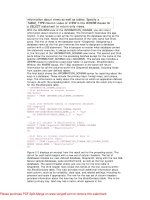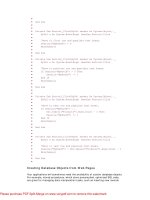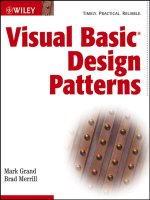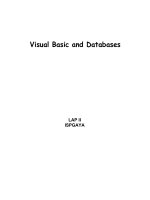Visual Basic Design Patterns pdf
Bạn đang xem bản rút gọn của tài liệu. Xem và tải ngay bản đầy đủ của tài liệu tại đây (7.62 MB, 593 trang )
Visual Basic
®
Design Patterns
01_268607 ffirs.qxd 6/10/05 10:22 PM Page i
01_268607 ffirs.qxd 6/10/05 10:22 PM Page ii
Mark Grand
Brad Merrill
Visual Basic
®
Design Patterns
01_268607 ffirs.qxd 6/10/05 10:22 PM Page iii
Visual Basic
®
Design Patterns
Published by
Wiley Publishing, Inc.
10475 Crosspoint Boulevard
Indianapolis, IN 46256
www.wiley.com
Copyright © 2005 by Wiley Publishing, Inc., Indianapolis, Indiana
Published simultaneously in Canada
ISBN-13: 978-0-471-26860-4
ISBN-10: 0-471-26860-7
Manufactured in the United States of America
10987654321
1B/SZ/QW/QV/IN
No part of this publication may be reproduced, stored in a retrieval system or transmitted
in any form or by any means, electronic, mechanical, photocopying, recording, scanning or
otherwise, except as permitted under Sections 107 or 108 of the 1976 United States Copy-
right Act, without either the prior written permission of the Publisher, or authorization
through payment of the appropriate per-copy fee to the Copyright Clearance Center, 222
Rosewood Drive, Danvers, MA 01923, (978) 750-8400, fax (978) 646-8600. Requests to the
Publisher for permission should be addressed to the Legal Department, Wiley Publishing,
Inc., 10475 Crosspoint Blvd., Indianapolis, IN 46256, (317) 572-3447, fax (317) 572-4355, or
online at />Limit of Liability/Disclaimer of Warranty: The publisher and the author make no repre-
sentations or warranties with respect to the accuracy or completeness of the contents of this
work and specifically disclaim all warranties, including without limitation warranties of fit-
ness for a particular purpose. No warranty may be created or extended by sales or promo-
tional materials. The advice and strategies contained herein may not be suitable for every
situation. This work is sold with the understanding that the publisher is not engaged in ren-
dering legal, accounting, or other professional services. If professional assistance is
required, the services of a competent professional person should be sought. Neither the
publisher nor the author shall be liable for damages arising herefrom. The fact that an orga-
nization or Website is referred to in this work as a citation and/or a potential source of fur-
ther information does not mean that the author or the publisher endorses the information
the organization or Website may provide or recommendations it may make. Further, read-
ers should be aware that Internet Websites listed in this work may have changed or disap-
peared between when this work was written and when it is read.
For general information on our other products and services or to obtain technical support,
please contact our Customer Care Department within the U.S. at (800) 762-2974, outside the
U.S. at (317) 572-3993 or fax (317) 572-4002.
Wiley also publishes its books in a variety of electronic formats. Some content that appears
in print may not be available in electronic books.
Library of Congress Cataloging-in-Publication Data:
Grand, Mark.
Visual Basic design patterns / Mark Grand, Brad Merrill.
p. cm.
Includes bibliographical references and index.
ISBN-13: 978-0-471-26860-4 (paper/website)
ISBN-10: 0-471-26860-7 (paper/website)
1. Microsoft Visual BASIC. 2. BASIC (Computer program language) 3. Software patterns.
I. Merrill, Brad. II. Title.
QA76.73.B3G683 2005
005.2'768 dc22
2005007862
Trademarks: Wiley and the Wiley logo are trademarks or registered trademarks of John
Wiley & Sons, Inc. and/or its affiliates, in the United States and other countries, and may
not be used without written permission. Visual Basic is a registered trademark of Microsoft
Corporation in the United States and/or other countries. All other trademarks are the prop-
erty of their respective owners. Wiley Publishing, Inc., is not associated with any product or
vendor mentioned in this book.
01_268607 ffirs.qxd 6/15/05 12:34 PM Page iv
About the Authors
v
Mark Grand is an Atlanta-based consultant specializing in Distributed Systems
Object Oriented Design and Java. He was the architect of the first commercial B2B
e-commerce product for the Internet. Prior to his involvement with Java, Mark spent
over 11 years as a designer and implementer of 4GLs. His most recent role in that vein
was as the architect and project manager for an electronic data interchange product.
Mark has worked with a number of MIS organizations in capacities such as Software
Architect, Database Architect and Network Designer.
Mark has been involved with object-oriented programming and design since 1982
and is now most widely known for his best-selling patterns books. Mark has taught for
U.C. Berkeley, Sun and other organizations. You can find more information about
Mark Grand at />Brad Merrill currently works as a software engineer on the ASP.NET team at
Microsoft. He’s previously worked as a .NET technology evangelist at Microsoft, and
as a software engineer at Sybase and Digital Equipment Corporation. His areas
of expertise are in distributed systems, transaction processing, operating systems,
and compiler technology. Brad lives in Redmond, Washington, and is an avid tourna-
ment chess player and bridge player. He can be reached at or
/>01_268607 ffirs.qxd 6/10/05 10:22 PM Page v
01_268607 ffirs.qxd 6/10/05 10:22 PM Page vi
Executive Editor
Robert M. Elliott
Development Editors
Emilie Herman
Eileen Bien Calabro
Ami Frank Sullivan
Technical Editors
Brad Abrams
Geoffrey Mroz
Rod Stephens
Production Editor
Angela Smith
Copy Editor
Foxxe Editorial Services
Editorial Manager
Mary Beth Wakefield
Vice President & Executive Group
Publisher
Richard Swadley
Vice President and Publisher
Joseph B. Wikert
Project Coordinator
Erin Smith
Graphics and Production Specialists
April Farling
Carrie A. Foster
Denny Hager
Stephanie D. Jumper
Quality Control Technicians
Leeann Harney
Jessica Kramer
Joe Niesen
Brian H. Walls
Proofreading and Indexing
Johnna Van Hoose
TECHBOOKS Production Services
Credits
vii
01_268607 ffirs.qxd 6/10/05 10:22 PM Page vii
01_268607 ffirs.qxd 6/10/05 10:22 PM Page viii
About the Authors v
Credits vii
Introduction xxiii
A Brief History of Patterns xxiv
Organization of this Book xxiv
Description of Patterns xxv
Pattern Name xxvi
Synopsis xxvi
Context xxvi
Forces xxvi
Solution xxvi
Implementation xxvi
Consequences xxvii
.NET Usage xxvii
Code Example xxvii
Related Patterns xxvii
Who Should Read this Book xxvii
What’s on the Companion Web Site xxviii
Chapter 1 Overview of UML 1
Class Diagram 2
Collaboration Diagram 14
Statechart Diagram 22
Chapter 2 The Software Life Cycle 25
Case Study 28
Business Case 28
Define Requirements Specification 29
Contents
ix
02_268607 ftoc.qxd 6/10/05 10:21 PM Page ix
Develop High-Level Essential Use Cases 30
Object-Oriented Analysis 32
Object-Oriented Design 34
Chapter 3 Fundamental Design Patterns 45
Delegation (When Not to Use Inheritance) 47
Synopsis 47
Context 47
Forces 50
Solution 51
Implementation 51
Consequences 52
.NET Usage 52
Code Example 52
Related Patterns 54
Interface 55
Synopsis 55
Context 55
Forces 56
Solution 56
Implementation 56
Delegates 57
Constructors 57
Consequences 58
.NET Usage 58
Code Example 58
Related Patterns 59
Abstract Base Class 61
Synopsis 61
Context 61
Forces 62
Solution 63
AbstractBaseclass 63
ConcreteClass1, ConcreteClass2, . . . 64
Implementation 64
Consequences 64
.NET API Usage 64
Code Example 64
Related Patterns 67
Interface and Abstract Class 69
Synopsis 69
Context 69
Forces 69
Solution 69
Consequences 70
.NET API Usage 70
Code Example 71
Related Patterns 72
x Contents
02_268607 ftoc.qxd 6/10/05 10:21 PM Page x
Immutable 75
Synopsis 75
Context 75
Forces 76
Solution 76
Implementation 77
Consequences 79
.NET API Usage 79
Code Example 79
Related Patterns 80
Proxy 81
Synopsis 81
Context 81
Forces 82
Solution 82
Implementation 83
Consequences 83
Code Example 83
Related Patterns 91
Chapter 4 Creational Patterns 93
Factory Method 95
Synopsis 95
Context 95
Forces 97
Solution 97
Implementation 99
Class Determination by Configuration 99
Data-Driven Class Determination 100
Consequences 101
.NET API Usage 101
Code Example 102
Related Patterns 107
Abstract Factory 109
Synopsis 109
Context 109
Forces 110
Solution 111
Implementation 113
Consequences 113
Code Example 114
Related Patterns 119
Builder 121
Synopsis 121
Context 121
Forces 124
Solution 124
Contents xi
02_268607 ftoc.qxd 6/10/05 10:21 PM Page xi
Implementation 126
The Build Process 126
Consequences 127
.NET API Usage 128
Code Example 128
Related Patterns 129
Prototype 131
Synopsis 131
Context 131
Forces 132
Solution 132
Implementation 133
Consequences 134
.NET API Usage 135
Code Example 135
Related Patterns 139
Singleton 141
Synopsis 141
Context 141
Forces 142
Solution 142
Implementation 143
Concurrent GetInstance Calls 144
Consequences 145
.NET API Usage 145
Code Example 146
Related Patterns 147
Object Pool 149
Synopsis 149
Context 149
Forces 151
Solution 152
Reusable 153
Client 153
ReusablePool 154
Implementation 154
Hiding the Object Pool 154
Delegating Object Creation 155
Ensuring a Maximum Number of Instances 155
Data Structure 155
Limiting the Size of the Pool 155
Managing Stateful Objects 156
Consequences 156
Code Example 156
Related Patterns 161
xii Contents
02_268607 ftoc.qxd 6/10/05 10:21 PM Page xii
Chapter 5 Partitioning Patterns 163
Filter 165
Synopsis 165
Context 165
Forces 166
Solution 166
Implementation 169
Consequences 170
.NET API Usage 170
Code Example 170
Related Patterns 174
Composite 175
Synopsis 175
Context 175
Forces 177
Solution 177
Implementation 179
Consequences 179
.NET Usage 180
Code Example 180
Related Patterns 185
Read-Only Interface 187
Synopsis 187
Context 187
Forces 189
Solution 189
Implementation 190
Consequences 191
Code Example 191
Related Patterns 192
Chapter 6 Structural Patterns 193
Adapter 195
Synopsis 195
Context 195
Forces 196
Implementation 198
Consequences 199
Code Example 199
Related Patterns 204
Iterator 205
Synopsis 205
Context 205
Forces 206
Solution 206
Contents xiii
02_268607 ftoc.qxd 6/10/05 10:21 PM Page xiii
Implementation 207
Generics 207
Additional Functions 208
Multiple Orderings 208
Null Iterator 208
Modification to the Underlying Collection 208
Consequences 209
.NET API Usage 209
Code Example 209
Related Patterns 211
Bridge 213
Synopsis 213
Context 213
Forces 216
Solution 216
Implementation 218
Consequences 218
.NET API Usage 218
Example 218
Related Patterns 223
Façade 225
Synopsis 225
Context 225
Forces 226
Solution 226
Implementation 227
Consequences 228
.NET API Usage 228
Example 228
Related Patterns 231
Flyweight 233
Synopsis 233
Context 233
Forces 236
Solution 236
Implementation 238
Consequences 239
.NET API Usage 239
Example 239
Related Patterns 244
Dynamic Linkage 245
Synopsis 245
Context 245
Forces 247
Solution 247
Implementation 248
Incompatible Classes 248
Security Risk 249
xiv Contents
02_268607 ftoc.qxd 6/10/05 10:21 PM Page xiv
Consequences 249
.NET API Usage 250
Code Example 250
Related Patterns 253
Virtual Proxy 255
Synopsis 255
Context 255
Forces 256
Solution 257
Service 257
Client 257
ServiceProxy 258
IService 259
Implementation 259
Shared Service Objects 259
Deferred Class Loading 259
Consequences 260
Code Example 261
Related Patterns 263
Decorator 265
Synopsis 265
Context 265
Forces 267
Solution 267
Implementation 269
Consequences 269
Code Example 270
Related Patterns 272
Cache Management 273
Synopsis 273
Context 273
Forces 274
Solution 275
Implementation 275
Structural Considerations 275
Implementation of the Cache 276
Performance-Tuning a Cache 277
GetHashCode( ) 281
Consequences 281
Code Example 282
Related Patterns 292
Chapter 7 Behavioral Patterns 293
Chain of Responsibility 295
Synopsis 295
Context 295
Forces 296
Solution 297
Contents xv
02_268607 ftoc.qxd 6/10/05 10:21 PM Page xv
Implementation 297
Consequences 299
.NET API Usage 299
Code Example 299
Related Patterns 304
Command 305
Synopsis 305
Context 305
Forces 305
Solution 305
Implementation 307
Undo/Redo 307
Avoid User Interface Dependencies 308
Consequences 309
.NET API Usage 310
Code Example 310
Related Patterns 315
Little Language 317
Synopsis 317
Context 317
Forces 328
Solution 328
Implementation 329
Consequences 330
.NET API Usage 331
Code Example 331
Related Patterns 342
Mediator 343
Synopsis 343
Context 343
Forces 345
Solution 345
Colleague1, Colleague2 . . . 345
EventHandler1, EventHandler . . . 346
Mediator 346
Implementation 347
Recursive Events 348
Consequences 348
Code Example 349
Related Patterns 354
Snapshot 355
Synopsis 355
Context 355
Forces 359
Solution 359
Implementation 363
Consequences 370
xvi Contents
02_268607 ftoc.qxd 6/10/05 10:21 PM Page xvi
Code Example 370
Related Patterns 372
Observer 373
Synopsis 373
Context 373
Forces 374
Solution 374
Implementation 376
Observing the Observable 376
Eliminating the Multicaster 377
Batching Notifications 378
Veto 378
Consequences 378
.NET API Usage 379
Code Example 379
Related Patterns 382
State 383
Synopsis 383
Context 383
Forces 386
Solution 386
Implementation 388
Consequences 388
Code Example 389
Related Patterns 394
Strategy 395
Synopsis 395
Context 395
Forces 396
Solution 396
Implementation 397
Consequences 397
.NET API Usage 397
Code Example 398
Related Patterns 400
Null Object 401
Synopsis 401
Context 401
Forces 402
Solution 402
Implementation 403
Consequences 403
Code Example 404
Related Patterns 405
Template Method 407
Synopsis 407
Context 407
Forces 408
Contents xvii
02_268607 ftoc.qxd 6/10/05 10:21 PM Page xvii
Solution 408
Implementation 410
Consequences 410
Code Example 410
Related Patterns 413
Visitor 415
Synopsis 415
Context 415
Forces 417
Solution 417
Implementation 421
Consequences 421
Code Example 422
Related Patterns 425
Hashed Adapter Objects 427
Synopsis 427
Context 427
Forces 430
Solution 431
Implementation 432
The Hash Table Data Structure 432
Alternate Data Structures 433
Consequences 433
Code Example 433
Related Patterns 435
Chapter 8 Concurrency Patterns 437
Single Threaded Execution 439
Synopsis 439
Context 439
Forces 442
Solution 442
Implementation 442
Consequences 443
Code Example 444
Related Patterns 446
Static Locking Order 447
Synopsis 447
Context 447
Forces 447
Solution 448
Consequences 448
Implementation 449
Known Uses 449
Code Example 450
Related Patterns 451
xviii Contents
02_268607 ftoc.qxd 6/10/05 10:21 PM Page xviii
Lock Object 453
Synopsis 453
Context 453
Forces 454
Solution 454
Implementation 455
Consequences 456
Code Example 457
Related Patterns 458
Guarded Suspension 459
Synopsis 459
Context 459
Forces 460
Solution 460
Implementation 461
Consequences 463
.NET API Usage 464
Code Example 464
Related Patterns 465
Balking 467
Synopsis 467
Context 467
Forces 468
Solution 468
Implementation 469
Consequences 469
Code Example 469
Related Patterns 470
Scheduler 471
Synopsis 471
Context 471
Forces 473
Solution 473
Implementation 476
Consequences 476
Code Example 476
Related Patterns 481
Read/Write Lock 483
Synopsis 483
Context 483
Forces 484
Solution 485
Implementation 486
Consequences 486
.NET API Usage 487
Code Example 487
Related Patterns 492
Contents xix
02_268607 ftoc.qxd 6/10/05 10:21 PM Page xix
Producer-Consumer 493
Synopsis 493
Context 493
Forces 494
Solution 494
Implementation 496
Consequences 496
.NET API Usage 496
Code Example 496
Related Patterns 498
Double Buffering 499
Synopsis 499
Context 499
Forces 500
Solution 501
Implementation 502
Multiple Buffers 502
Threads 502
Exception Handling 503
Consequences 503
.NET API Usage 504
Code Example 504
Related Patterns 518
Asynchronous Processing 519
Synopsis 519
Context 519
Forces 521
Solution 521
Implementation 522
Request Management and Thread Allocation 522
Outcome Management 524
Consequences 524
.NET API Usage 525
Code Example 525
Related Patterns 527
Future 529
Synopsis 529
Context 529
Forces 530
Solution 531
Implementation 532
Polling 532
Proxy 533
Launching a Synchronous Computation 533
Rendezvous 534
Exceptions 534
xx Contents
02_268607 ftoc.qxd 6/10/05 10:21 PM Page xx
Consequences 534
.NET API Usage 534
Code Example 536
Related Patterns 540
Bibliography 541
Index 543
Contents xxi
02_268607 ftoc.qxd 6/10/05 10:21 PM Page xxi
02_268607 ftoc.qxd 6/10/05 10:21 PM Page xxii
Introduction
xxiii
Experience gives programmers a variety of wisdom. As programmers gain experience,
they may recognize new problems as being similar to problems they have solved
before. With even more experience, they recognize that solutions for similar problems
follow recurring patterns. By being aware of these patterns, experienced programmers
recognize situations that patterns apply to and immediately use the solution without
having to stop, analyze the problem, and pose possible strategies.
Software patterns are reusable solutions to recurring problems you encounter dur-
ing software development. When a programmer discovers a pattern, it is just an
insight. In most cases, to go from an unverbalized insight to a well thought out idea
that the programmer can clearly articulate is surprisingly difficult. It is also an
extremely valuable step. When we understand a pattern well enough to put it into
words, we are able to intelligently combine it with other patterns. More importantly,
once put into words, a pattern can be used in discussions among programmers who
know the pattern. That allows programmers to more effectively collaborate and com-
bine their wisdom. It can also help avoid the situation of programmers arguing over
different solutions to a problem, only to find that they were really thinking of the same
solution but expressing it in different ways.
Putting a pattern into words has an additional benefit for less experienced pro-
grammers who have not yet discovered the pattern. Once a pattern has been put into
words, more experienced programmers can teach it to programmers who do not know
the pattern.
The value of this book is that it gives experienced programmers a common vocabu-
lary to discuss patterns. It also allows programmers who have not yet discovered a pat-
tern to learn about the pattern.
Though this book includes a substantial breadth of patterns, there are additional
patterns the author knows but did not have time to put in the book. You, dear reader,
may discover some patterns yourself. Some patterns you discover may be highly spe-
cialized and only of interest to a small number of people. Other patterns may be of very
03_268607 flast.qxd 6/10/05 10:21 PM Page xxiii
broad interest and worthy of inclusion in a future volume of this book. If you wish to
communicate such a pattern to this book’s author, you may send e-mail to mgrand@
mindspring.com.
The patterns cataloged in this book convey constructive ways of organizing parts of
the software development cycle. There are other patterns that recur in programs that
are not constructive. These are called anti-patterns, because anti-patterns can cancel out
the benefits of patterns. This book does not attempt to catalog anti-patterns, as the sub-
ject is well covered in other books. Readers who are interested in anti-patterns may
enjoy reading [BMMM98].
Note
Because this book is all about software patterns, they are simply referred to as
patterns in the rest of this book.
A Brief History of Patterns
The idea of software patterns originally came from the field of building architecture.
An architect named Christopher Alexander wrote some books describing patterns in
building architecture and urban planning. Some of those books are A Pattern Language:
Towns, Buildings, Construction (Oxford University Press) and The Timeless Way of Build-
ing (Oxford University Press).
The ideas presented in those books are applicable to a number of fields outside of
architecture, including software.
In 1987, Ward Cunningham and Kent Beck used some of Alexander’s ideas to
develop five patterns to guide the design of user interfaces. They published a paper
on them at OOPSLA-87. The paper was titled, “Using Pattern Languages for Object-
Oriented Programs”.
In the early 1990s, four authors began work in a very influential book called Design
Patterns by Erich Gamma, Richard Helm, John Vlissides, and Ralph Johnson (Addison-
Wesley). It popularized the idea of patterns and was the largest single influence on this
book. The Design Patterns book is often called the “gang of four book” or GoF. This
book used C++ and Smalltalk for its examples, as UML did not exist when it was writ-
ten. UML is now widely accepted as the preferred notation for object-oriented design,
so UML is the notation used in this book. Visual Basic .NET Design Patterns uses
VB.NET for its examples. The pattern descriptions are presented from a VB.NET point
of view.
Organization of this Book
This book focuses on design patterns that are used at the micro-architectural level. The
first two chapters contain material to help you understand the patterns presented in
the chapters that follow.
xxiv Introduction
03_268607 flast.qxd 6/10/05 10:21 PM Page xxiv









